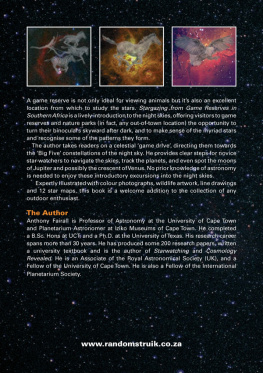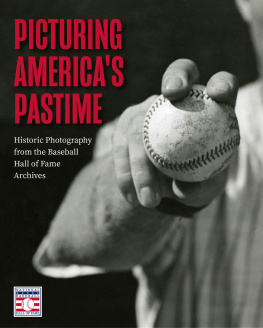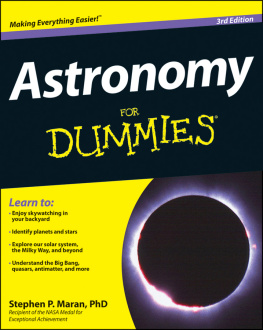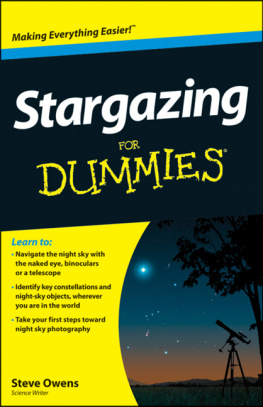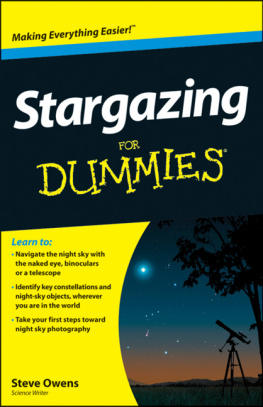

Text copyright 2019 by Chronicle Books LLC.
All rights reserved. No part of this book may be reproduced in any form without written permission from the publisher.
ISBN 9781452175096 (epub, mobi)
Library of Congress Cataloging-in-Publication Data
Names: United States. National Aeronautics and Space Administration, author. | Nye, Bill, writer of preface. | Nataraj, Nirmala, writer of added text.
Title: Stargazing : photographs of the night sky from the archives of NASA / preface by Bill Nye ; text by Nirmala Nataraj.
Description: San Francisco : Chronicle Books, [2019] | Includes bibliographical references.
Identifiers: LCCN 2018045946 | ISBN 9781452174891 (hardcover)
Subjects: LCSH: Astronomical photography. | Sky--Pictorial works. | Night photography. | United States. National Aeronautics and Space Administration--Photograph collections. | Outer space--Pictorial works.
Classification: LCC QB121 .U56 2019 | DDC 520.22/2--dc23 LC record available at https://lccn.loc.gov/2018045946
Design by Kristen Hewitt.
Chronicle books and gifts are available at special quantity discounts to corporations, professional associations, literacy programs, and other organizations. For details and discount information, please contact our premiums department at or at 1-800-759-0190.
Chronicle Books LLC
680 Second Street
San Francisco, California 94107
www.chroniclebooks.com
PREFACE
by Bill Nye
Tonight, lookjust look up and out at the night sky. The scale of the cosmos is more than anyone can grasp. But with this book, you can give it a try. Reach out, and hold a finger at arms length. Now swing your arm skyward, and gaze up. Youre occluding more stars from your view than you could count in a lifetime. Hence the expression billions and billions. As you look at the stunning pictures in this volume, I hope you get a wonderful sense of just how much there is to see out there. Most of us are city dwellers; we can see only a tiny fraction of whats up at night. Even on a moonless night, our cities produce so much light that we only perceive a few bright points: Jupiter, Saturn, or Mars, the red planet, which glows just a little bit orange, by the way. But if you can take the time to get out and away from city lights, youll get a glimpse of our beginnings. Youll look in on where we all came from.
Through millennia of diligent observations, stargazer scientists have discovered that all the chemical elementsall the water, all the air, indeed all of whatever molecules make up you and meare made of the atomic material of ancient stars. It all gets driven into the blackness of space by explosions, brought on when the extraordinary process of stellar fusion overwhelms the crush of gravity in a star. Along with the glowing stars in the night sky, then, is the dust of other stars, and its the dust that comprises everything you know and love. To get a few good looks at all those stars and all that dust up close, turn these pages.
Because of a drive deep within us to know the cosmos and our place within it, and a drive to keep ahead of others of our kind (who might be members of other tribes, other lands, and other countries), weve designed and built extraordinary means to capture images of the night sky. Earths citizens invest billions of dollars, euros, rupees, yuan, and yen in the means to study the heavens. Taxpayers around the world have funded and built optical telescopes, radio dishes, and amazing spacecraft, as well as whole cities to support them. Here in the United States, the organization doing this work is the renowned National Aeronautics and Space Administration. Its so famous that its acronym is enough: NASA evokes respect for technical achievement, remarkable accomplishment, and wonderment for our Earths place in outer space. So, this book is a compilation of some of the remarkable and frankly astonishing images that NASA has captured through its nightly work over the last six decades. It shows again that space exploration brings out the best in us. These NASA photographs of stars, taken from the ground and from the spacecraft built to study them, fill me with admiration and awe. Even photographs of our spacecraft and the rockets to launch them are amazing. In a glance, you get a sense of the remarkable power and thrust required to send our instruments and astronauts into the darkness.
Like a great many high-quality books, this one is printed on smooth white paper, and the words are produced with jet-black ink. But unlike almost every book youll ever hold in your lap and admire, this one has large sharp rectangles of black carrying the awesome colorful details of our Earths sky at night. Heres hoping this book inspires you to admire every page and to go out and see it all for yourself.

PERSEID SHOWER 2016
This 30-second exposure captures a meteor streaking across the sky in Spruce Knob, West Virginia. Upon entering the atmosphere, a meteor compresses the air in front of it, which can heat the meteor up to 3,000 degrees Fahrenheit (1,650 degrees Celsius). Most meteors are vaporized, generating the shooting stars we see in the skies. The annual Perseid shower is most visible right before dawn, when the area of Earth closest to the Sun during Earths orbit picks up even more meteoric debris. The best way to observe the Perseid shower is to allow your eyes to adjust to the dark for roughly 45 minutes, and then simply lie on the ground and look up.
INTRODUCTION
Is there anything to rival the beauty of a clear night sky? The mathematician Ptolemy poetically described the archetypal awestruck gaze that humans cast up into the firmament: I know that I am mortal by nature, and ephemeral; but when I trace at my pleasure the windings to and fro of the heavenly bodies I no longer touch the Earth with my feet: I stand in the presence of Zeus himself and take my fill of ambrosia.
Whether we gaze up and out into the cosmos to better understand our place within it, to chart a course through unknown waters, to determine our proximity and relationship to other celestial bodies, or simply to drink in the beauty and mystery of the fathomless reaches of space, the night sky is a destination of timeless wonder.
Today, we use binoculars, telescopes, ground and space observatories, or simple apps on our smartphones to determine the placement of stars and galaxies (or even a satellite whizzing just outside Earths atmosphere). But stargazing was something that any amateur sky watcher could do without obstruction for most of human history. Many ancient civilizations used the stars for accurate navigation, and still others used them as markers for myths and illustrations of cultural values writ large in the skies. And the star maps that early scientists created, even in ancient times, would come to inform the modern eye.
To our knowledge, the first comprehensive star atlas was created in 650 CE in Western China, in a small town along the Silk Road. It appears to have been carefully inscribed on a piece of paper, and was found in a temple back in 1907, when a Taoist monk accidentally crashed into a wall and stumbled upon an ancient archive of documents and sculptures.
The first telescopes emerged in the seventeenth century. They evolved from earlier models, used by the likes of Galileo and Isaac Newton, to a 150-foot-long (46-meter-long) device designed by Johannes Hevelius (touted as the founder of lunar topography). In 1609, Galileo was the first person to record the night sky with the use of a telescope. His first significant discovery was that certain stars in the sky were actually moons that orbited Jupiter.
Next page

